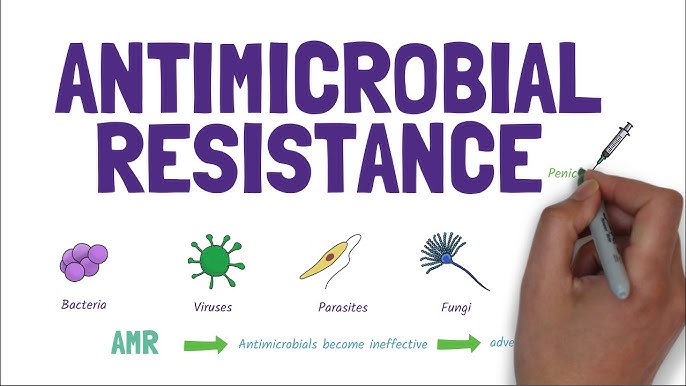Recently, the World Health Organization (WHO) has prepared a draft Global Action Plan to deal with emerging and complex problem of antimicrobial resistance
Antimicrobial resistance (AMR) is defined as resistance of microorganisms (bacteria, viruses, fungi or parasites) — to an antimicrobial agent against which they were thought to be previously sensitive. AMR is emerging as a grave issue of global epidemic and is usually unrecognized. As per a report published in Lancet in January 2022, bacterial AMR caused 4.95 million deaths globally by 2019 and without any effective action plan — is predicted to cause 10 million deaths annually by 2050( as per another study).
Though development of resistance is a natural phenomenon, its amplification and spread through certain faulty practices is concerning. It is exacerbated to most extent by the underlying factors like misuse of antimicrobial medicines – their overdosing/overprescribing/under-dosing and being prescribed for inappropriate indications; insufficient access to quality antibiotics; lack of a comprehensive and coordinated response; weak or absent antimicrobial resistance surveillance and monitoring systems; poor infection control practices; and unhealthy self-medication behaviour among people.
The first and foremost rule of antibiotic use is that they are ideally indicated to fight bacterial infections and don’t work on viruses except for their role in preventing secondary infections in critical viral illnesses. For example, a common cold or cough is most likely caused by a viral infection and antibiotics should not be primarily prescribed. However, it is seen that around 80% of patients with symptoms of mild acute respiratory infections are likely to receive an antibiotic when the cause is viral. Moreover, the phenomenon is also affected by the misconceptions that antibiotics are crucial for all infections, which is actually not justified.
Regarding the history of development of AMR, resistance to sulphonamides and penicillin was reported as early as 1940s followed by resistance to other antimicrobials subsequently including fluoroquinolones and other beta-lactam antibiotics(carbapenems, cephalosporins), and antimalarials. Moreover, newer and newer antibiotics have been challenged with the threat of resistance over past few decades. Resistance combined with virulence is acting as a potentially deadly duo. Today, almost all major infectious diseases of public health concern are faced with the threat of AMR.
The incidence of hospital-acquired infections caused by highly resistant bacteria such as methicillin resistant staphylococcus aureus (MRSA) or multidrug resistant gram-negative bacteria is steadily rising. Besides that, Vancomycin Resistant Enterococci (VRE), Extended Spectrum Beta-Lactamase (ESBL) producing Enterobacteriaceae, Carbapenem resistant Klebsiella (CRK), pan drug resistant (PDR) Pseudomonas and Acinetobacter, drug resistant E.COLI, SALMONELLA, including antifungal resistant fungi(most evolving as per WHO 2022 data), antiviral resistant viruses, and others are creating a havoc in treatment facilities around the world — causing deaths and delaying healing. According to WHO, the death rate for patients with serious infections treated in hospitals is about twice that in patients with infections caused by non-resistant bacteria.
Additionally, antibiotics are also overused in agriculture, livestock rearing and fishing industry — thus making chances of resistant bacteria to get transferred to humans through contact with livestock, through the food chain, and through wastewater from these operations, as well as from hospitals and pharmaceutical plants.
AMR hampers the control of infectious diseases and delays treatment, thus rendering patients infectious for longer periods, while at the same time increasing the risk of spreading resistant micro-organisms to others. The longer duration of illness and treatment increases healthcare costs and the economic burden to families and societies. Apart from that, direct increase in cost of higher antibiotics, associated expenses like longer ICU stays, repeated lab culture and sensitivity tests and ward charges put even more financial burden on the patients, their families and the overall health care system.
Besides posing a concerning threat to secondary and tertiary healthcare, AMR poses a significant challenge to primary healthcare system. While majority of the population, especially in the rural areas — is dependent on grass root government healthcare services for primary healthcare, most of the antimicrobials available in the Sub Centres and Primary Health Centres are essentially first generation drugs. So, the curative component of the entire Primary Health Care system can collapse if AMR is not dealt in with a systematic manner.
To wake up to the issue, there has been national and international efforts to halt or slow the progress of AMR. The WHO aptly selected the theme for World Health Day 2011 as “Antimicrobial resistance: No action today, no cure tomorrow”.
Recently, the World Health Organization (WHO) has prepared a draft Global Action Plan to deal with emerging and complex problem of antimicrobial resistance. As per WHO, global collective action is required — to ensure that the prevention tools, diagnostics and therapies needed to reduce the infectious disease burden are available and affordable to everyone, everywhere; to reduce the need for antimicrobials and ensure their responsible use through prevention efforts, infection control, surveillance and appropriate prescriptions; and to develop the next generation of antimicrobials, vaccines, diagnostics and infection control technologies.
Moreover, the thrust areas suggested were education to patients, prescribers and dispensers at all levels; better implementation and strengthening of existing infection control programmes; monitoring the activities of pharmaceutical companies; phasing out the use of antimicrobials for growth promotion in animals and plants if they are also used for treatment of humans; and encourage cooperation between industry, government bodies and academic institutions in the search for new drugs and vaccines.
Even though the Govt. of India has formulated the National Policy for Containment of Antimicrobial Resistance in 2011 and there is ample scope for improving our healthcare systems to reduce AMR. As per the Policy, the factors like inadequate control on over-the-counter sale of antimicrobials, their inappropriate use by clinicians/pharmacists and lack of coordination in resistance surveillance are the main road-blocks in our country to tackle AMR.
Hence, a three pronged approach to tackle this menace can be think upon. Firstly, regulations on the sale of over the counter antimicrobials does influence the consumption and hence the spread of resistance, therefore levying fines on the dealers who indulge in such practices by the regulatory authorities is a long standing need. Secondly, allopathic doctors as well as practitioners of other forms of healing must be encouraged to get involved in continuous education regarding the trends in AMR in their areas. Finally, a hospital-based sentinel surveillance system for monitoring resistance can be established across the country.
Though there are definite policies and guidelines for appropriate use of antimicrobials in specific national health programmes such as for TB, AIDS and malaria, the same are not available for other diseases of public health importance like enteric fever, diarrhoeal diseases, respiratory infections etc. Therefore, establishing standard treatment guidelines for common infectious diseases will go a long way in achieving uniformity in treatment and reduction in newer generation drugs getting resistant.
Moreover, effective public health measures such as improved hygiene and sanitation with placement of effective infection control practices, improving immunization coverage to vaccine preventable diseases, rapid outbreak response, effective IEC — will reduce reliance on antimicrobials and break the chain of transmission of resistant microbes. And there is a need to identify the burden of AMR, develop concerted multipronged strategy, infrastructure and take coordinated steps to tackle this serious public health challenge.
More to say, there is a crucial need to pass ‘Declarations’ in hospital settings, that should be lead by a team of expert doctors to play a key role in getting respective hospitals to wake up to the issue by issuing guidelines. At the first place, it only requires a change in mind-set – like encouraging the judicious use of antibiotics in all settings of care; avoiding prescribing or taking antibiotics for common viral infections, to avoid selling of antibiotics over the counter unprecedentedly without legal prescriptions and a few basic infection control precautions for hospital-based workers — for instance, using a hand rub/hand wash before and after examining the patient — will go a long way in controlling the spread of resistant bugs, as well as hospital-acquired infections.
(Author is B.SC, M.B.B.S, CPCDM (Diabetes), ECMEC (UEMS – EACCME) RSSDI Certified in Diabetology IDF Certified in Diabetology. Member, Research Society for the Study of Diabetes in India (RSSDI). Certified by Stanford University School of medicine, USA in Antimicrobial Stewardship. Feedback: [email protected])








